"The spear of fate" of the ancient Slavs of the XNUMXth-XNUMXth centuries
foreword
This article continues the cycle about Slavic weapons early period.
In addition to fairly well-known information from written and archaeological sources, analysis of modern historiography, we use data from folklore, mythology, since at this stage of the development of society, weapons, in addition to an understandable utilitarian function, bore the imprint of a person's mental representations of a tribal organization.
Entry
The spear is the oldest weapon and hunting weapon. The emergence of the term "spear" refers to the Proto-Slavic period, it is a product of their own morphological development of the Proto-Slavs.
Along with the spear, other names for this weapon were used in the Slavic language.
Oskop - once mentioned in the Ipatiev Chronicle, a type of spear under 1123, initially a sharpened stake (L. Niederle, Ipatiev Chronicle). Oskep, or oschep, is the name of the spear, which was more used among the Western Slavs.
There is an assumption about the presence of sharpened fired stakes among the Slavs, which were also used in the XNUMXth century. and with which the "bulk (not warriors) of the male population" was armed and before which "neither a shield nor a shell" could resist (Polyakov A.S.).
Ostrog is a term that also refers to the early stories Slavs.
The ancient names for the spear were also "bodilo" and "birth", both go back to the horn, the horns of the cow, that is (presumably) associated with a weapon that could have a horn at the tip. Hence the expression: "do not ask for trouble" (Odintsov GF).
Early written sources tell us about the weak weaponry of the Slavs, but the main among them, at least for the XNUMXth century period, was the javelin.
Tribal society of the Slavs and weapons
This or that weapon, especially in the early historical stages, reflects the state of society. The socio-economic situation of the early Slavs at the beginning of the XNUMXth century. can be characterized as tribal relations and a low level of material culture. The lack of stratification of society does not allow us to speak of any kind of separation of professional soldiers or professional military formations. It is categorically impossible to agree with the attempt to find these structures in the Slavic society in the period we are considering (which we wrote about in our previous works on "VO").
Throwing spears or javelins were the main, one might say, epic weapon among peoples at this stage of development. It was in the throw of the spear, hitting the target that the will of the gods and the luck of the one who used it were clearly visible (Khlevov A.A.).
The Gothic hero in the battle with the Huns in the "Song of Chlode" of the "Elder Edda" said:
A spear, as I said!
It is with this weapon that the birth of a warrior from a successful hunter is associated. By the way, the sword is a symbol of the belligerence of a weapon of another period in the development of society.
Of course, in different historical situations with the specific borrowing of more modern weapons, the situation is different. The Indians of North America, standing at different stages of the tribal system, received small arms and horses, which significantly increased their level of weapons, but did little to help in a clash with a society at a higher stage of development.
If we talk about the situation in Europe during the XNUMXth-XNUMXth centuries, then certain weapons, in our opinion, reflected the stages of development, the changes of which we cannot trace in detail.
As for the early Slavs, the sources do not give us any information about the spear as a specific symbol and marker of the development of society and its military component. Unlike other types of weapons, but more on that later.
It is in the situation described that we see the modest weapons of the Slavs, with which they appeared on the borders of Byzantium. Procopius of Caesarea writes about this in the 50-60s. VI century
Slavic throwing weapon
To designate the Slavic spear, Procopius used the term acontia (ακόντιον). Some authors translate it into Russian as a dart, others as a spear.
The same description of the weapons of the early Slavs is given by the contemporary of Procopius, John of Ephesus, who wrote his history almost until his death in 586.
He reported that the main weapons of the Slavs were two, three javelins. Such weapons, in his opinion, were the main ones until the 80s of the XNUMXth century. But from this period, the Slavs took possession of the Eastern Roman weapons, as discussed below.
He uses the name Lonhadia (λογχάδία). The translation, which most reflects its essence, sounds like a "spear" (Serikov NI).
I think that this term was not used by John by accident, it goes back to lonche (λόγχή) in Greek, or lancea in Latin. This spear was also used as a throwing one: legions of Lanciarii specialized primarily in throwing spears. And some regiments of Lanciarii, of course, having long lost their specialization, survived until the XNUMXth century.
We are far from thinking to ascribe to John of Ephesus the building of such a far-reaching scheme, but, perhaps, the name that he used was well founded. In this case, lonhadia is a throwing spear shorter than a lonha.
The author of "Strategicon" gives the same description of Slavic copies of the late XNUMXth century, possibly the beginning of the XNUMXth century.
He, listing the necessary equipment for a lightly armed infantryman (psilla), puts next to him a berite and a "Sklavin-type dart" (λογχίδια Σκλαβινίσκια). Byzantine psillas were supposed to use berites.
Berite (berite) was a short throwing spear, larger in size than a dart and different from an aconist dart (άκόντιον (singular)). But less than a throwing lonch.
Comes from the Latin veru, verutus. According to Vegetius, the length of the arrowhead is 5/12 Roman feet ≈ 12,3 cm, the length of the shaft is 3,5 feet ≈ 103 cm. “Verutum, which was originally called vericulum,” wrote P. Connolly, “had a 12 cm long arrowhead and a wooden the shaft is a little longer than a meter. "
We do not know how the tip of the verut looked and how it differs from the tips of darts, but we see that its size was quite small.
The data given by P. Connolly are of a presentation nature and are not a collection of arrowheads of the entire spectrum of small copies found in large numbers in the places of the documented location of Roman troops, for example, in the places of legions' camps. At the moment, the finds of small arrowheads can only be conditionally divided according to their size.
The term "berite" is used in the most archaic, XII part of the "Strategicon", and this Latin-language name is gradually giving way to Greek, more modern terms (V.V. Kuchma).
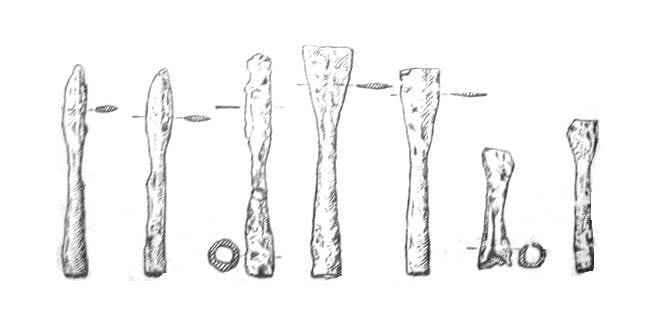
In the "Tactics" of Leo VI the Wise (870-912), a similar throwing weapon, intermediate between a dart and a full-fledged spear, is called riktaria (ρικτάριον):
Leo VI writes directly that the Slavs were armed with riktarians.
The need for the use of weapons of hostile neighbors, whether it be Mauritanian javelins or spears of the Slavs, was dictated by the specifics of hostilities. The author of "Strategicon" informs about it in his instruction:
Akonists, or acontobolists (John Lead), are an intermediate type of troops between heavily armed and lightly armed infantrymen, not characteristic of the military tradition of the Romans, but appearing because of the combat specifics, when the use of a regular battle in a guerrilla war-raid became impossible. Despite the fact that their name comes from the dart, they are not always armed with darts, like psils, but with spears for throwing and, possibly, darts (Kuchma V.V.).
The Slavs, whose skills in war in the forest were natural, were excellent spear throwers. Agathius of Mirinei described such an extraordinary episode of the period of struggle between the Byzantines and the Iranians in 555:
The heavy use of throwing weapons was a hallmark of combat at this time:
And among the Slavs, throwing weapons were the main ones. Therefore, the Slav Svarun, who fought in the ranks of the Romans, using this skill, deftly and accurately threw a spear (δόρυ) at the target.
In 594, a detachment of Slavs, surrounded in a fortification of carts (Karagon or Wagenburg), skillfully fights off the Romans with the help of throwing spears (ακόντια), striking the horses of the Romans, and only the decisiveness of the Byzantine commander allowed the stratiots to break through the defenses of the Slavs.
In 677, during the siege of Thessalonica, the author of The Miracles of St. Dmitry of Thessalonica (ChDS) among the Slavic army separately points to the unit of the Aconists.
It is possible that, along with a short throwing spear, the Slavs could use larger spears. It can be assumed that their number has increased since the beginning of the XNUMXth century. under the influence of ethnic groups and states with which the Slavs had clashes and contacts.
Slavic spears (λόγχή) were mentioned during the siege of the 10-20s of the 705th century. Thessaloniki at the ChDS. There is direct evidence of the use of spears by the Slavs during the battle in the mountains near Friul in XNUMX at Paul Deacon.
But the mass "national" weapon of the Slavs throughout the XNUMXth century, and, most likely, the XNUMXth century, were small throwing spears, smaller than an ordinary spear, but longer and more darts. Vasilevs Leo VI the Wise, also really familiar with the contemporary Slavs of the XNUMXth century, does not write about any other weapon, except for the one mentioned in Mauritius, only denotes it, as we indicated above, in modern terms.
Along with this, we know the ethnos, whose "national" weapon was precisely the long spear - these were the Goths.
The use of one or another type of weapon depended on the material condition of different tribal groups of Slavs.
The use of the same weapon, short spears, by both Antae and Sklavins, indicates a low material level of these tribal unions in the XNUMXth century, which is confirmed archaeologically. And it also testifies that this society has not passed to the stage of "expansion", using hunting tools as a weapon.
A full-fledged spear is an offensive weapon. As part of the Slavs passed at the end of the VI century. and throughout the VII century. from raids and guerrilla warfare to seizures of lands, sieges of fortresses and cities, weapons are also changing.
Archeology about the Slavic spear
Archaeological data do not give us a sufficient idea of the Slavic piercing weapon.
This fact compels researchers to make generalizations against the broad background of the history of Eurasia. There is nothing wrong with this and such a method is quite acceptable if it were used in the presence of extensive archaeological material, for example, as in the case of the Lombard monuments of this period and their comparison with the archaeological finds of Avar weapons.
The few finds of Slavic spearheads were classified into four groups. The picture looks like this:
1. Tip with a leaf-shaped or diamond-shaped point, according to another classification - lanceolate.
2. Small harpoon-like (with teeth) tips (angona).
3. Small tips in the form of a tapered leaf.
4. Small tips with a square section (Kazansky MM).
Type 1 and 2 - socketed, type 3 and 4 - petiolate. The first type is found everywhere in Europe; within the archaeological cultures of the Slavs, six arrowheads are indicated. Two more of the same spears were in the hoard from Koloskov on Stary Oskol (Rybakov B.A., Lyapushkin I.I., Shuvalov P.V.).
The average length of these medium-sized tips is about 21 cm (20-25 cm), half the length per sleeve. For comparison: the tips of the steppe peaks of this period are of the same size.
In our opinion, a tip from the Surskaya Zabora, near the village. Voloshskaya (Ukraine) falls out of the presented and so rare finds.
If we compare these finds with the early Old Russian ones, then we can say that the continuity is very weak, only type 1 spears can be correlated with type III according to A.N. Kirpichnikov. The authors of the article on Old Russian weapons see in this type a common Slavic origin, with which it is difficult to agree due to the significant prevalence of this type of tip in the period under review in Europe (Kirpichnikov A.N., Medvedev A.F.)
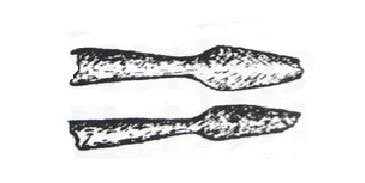
What was indicated in an earlier work on ancient Russian weapons by A.N. Kirpichnikov, but the opinion that spears of type III according to Kirpichnikov's classification and type I according to Kazansky prevailed in Bulgaria in the XNUMXth-XNUMXth centuries deserves attention.
The presence of such arrowheads among neighboring peoples, the presence of finds that significantly exceed the Slavic ones, do not allow, in our opinion, to interpret this javelin as purely Slavic (Shuvalov P.V.).
If the compiler of the list of Slavic finds of type II arrowheads classifies them as Slavic weapons, then his critics suggest that the Angona-type arrowheads 17-20 cm long were borrowed from neighbors. And their finds are concentrated on the extreme north-western border of the Slavic world (Kazansky M.M., Shuvalov P.V.).
Based on these few finds collected by M.M. Kazansky. and supplemented by P.V. Shuvalov, it is difficult to draw a conclusion about what kind of arrowheads the Slavic throwing weapon actually had, one can only assume that they were of a similar type with the weapons of other peoples. From the listed finds, we do not see anything specific in the weapons, which could prompt the author of the "Strategicon" to point to the use of "Slavic copies".
It can be assumed that they are related to the loncha (λόγχή) by a narrow tip blade, such as in types 3 and 4 according to M.M. Kazansky, with sizes ranging from 15,5 to 19 cm, but in size they are obviously closer to the dart tips.
We also have several finds of spearheads on the territory of Slavic settlements from Zimno, Bliznaki and Nikodimovo (3 points), but they are of Avar or late Hunnic origin, these finds look extremely poor against the background of the same Lombard spearheads borrowed from the Avars (Kazan M.M. .).
The discoverer and researcher of the famous archaeological early Slavic monument Zimno noticed that more weapons were found in this one settlement than in the rest of the territory inhabited by the ancient Slavs (Aulikh V.V.).
Summing up, it should be said that the Slavs, according to written sources, were armed with a specific type of throwing spear, which was written about by all Byzantine authors describing their weapons. Due to their extreme scarcity, archaeological finds do not clearly identify the appearance of this weapon.
Subtotals
We think that the peculiarity of the "Slavic spear" does not lie in the plane of the specifics of their structure. As shown in historiography, Slavic spears were slightly more berite. This size has developed organically in the course of primarily economic activities (hunting) as the most convenient size for throwing.
The originality of the "Slavic spear" was precisely in the method of application. Not in technological features, but in the specifics of the application.
In the case of the analysis of the attitudes of the author of "Strategicon", who instructed the soldiers how to use Sklavin's spears along with berites, we are faced with a logical error of transferring the result (effective use of throwing javelins) from a reason (thrower) to an object or instrument of activity (spear). Those. see efficiency in the spear, not in the thrower.
This distinctiveness consisted in the accuracy of the throw, which, as we see it, was characteristic of a society actively engaged in hunting in the forest zone. Accuracy along with massive use of projectiles. This is the specificity of the "Slavic spear", outwardly, as we see, it did not differ much from other European counterparts.
It is significant, but after the departure from exclusively partisan tactics and raids and the transition to expansion from the end of the XNUMXth and throughout the XNUMXth century. the palm tree among the Slavs goes to the bow, as the sources tell us. The same Mauritius, during the war with the Slavs in the forest, did not recommend the use of toxots (archers), but in the struggle for the seizure of land in the Balkans, the capture of settlements and fortresses from the Slavs, the bow, which was previously a natural tool of management (hunting), comes to the first plan: the arrow strikes further than a spear or spear.
Sources and Literature
PSRL.T.2. M., 1998.
Procopius of Caesarea. War with the Goths. About buildings. Translated by S.P.Kondratyev. T. II. M., 1996.
N.V. Pigulevskaya Syrian Medieval Historiography. Research and translations. Compiled by E.N. Meshcherskaya SPb., 2011.
Strategicon of Mauritius / Translation and commentary by V.V. Kuchma. SPb., 2003.
Flavius Vegetius Renatus. A summary of military affairs. Translation and comments by S.P. Kondratyev, St. Petersburg, 1996.
Leo VI the Wise. Leo tactics. The publication was prepared by V.V. Kuchma. SPb., 2012.
About combat escort. About the structure of the camp. The publication was prepared by V.V. Kuchma. SPb., 2002.
Etymological Dictionary of Slavic Languages.
Proto-Slavic lexical fund. Edited by O.N. Trubachev. Issue 11.M., 1984.
Niederle L. Slavic Antiquities, M., 2013.
Odintsov G.F. On the history of the name of the oldest Russian copies // Etymology. 1977. Ed. J.J. Warbot, L.A. Gindina, G.A. Klimova, V.A. Merkulova, V.N. Toporova, O. N. Trubachev. Moscow: Nauka, 1979.
Polyakov A.S. Warfare among the Slavs in the 2005th-XNUMXth centuries. Abstract dissertation. for a job. scientific degree Ph.D. SPb., XNUMX.
Shuvalov P.V. Urbicius and the "Strategicon" of Pseudo-Mauritius (part 2) // Byzantine Calendar. T. 64.M., 2005.
Connolly P. Greece and Rome. Encyclopedia of Military History / Translated by S. Lopukhova, A. Khromova. M., 2002.
Rybakov B.A. Ancient Rus / SA T. XVII M., 1953.
Kirpichnikov A.N. A.F. Medvedev Armament.
Ancient Russia. City, castle, village. Edited by B.A. Kolchin / Archeology of the USSR. M., 1985.
Kirpichnikov A.N. Old Russian weapons. Archeology of the USSR. Issue 2.M., 1966.
Shuvalov P. V. Weapons of the early Slavs // Cultural transformations and mutual influences in the Dnieper region at the end of the Roman time and in the early Middle Ages, 2004. Volume 11. Proceedings of the Institute for the History of Material Culture. SPb., 2004.
Kazansky M.M. Steppe traditions and Slavic weapons and horse equipment in the 254th-2019th centuries / KSIA. Issue XNUMX.M., XNUMX.
Aulikh V.V. Zimnivske ancient settlement - words of the memorial of VI-VII centuries not. in the Wolin. Kiev, 1972.
Kazanski M. L'armement Slave du haut Moyen-Age (Ve-VII-e siecles).
A propos des chefs militaries et des guerriers professionnels chez les anciens Slavs // Pfehled vyzkumu. No. 39 (1995-1996). Brno.
To be continued ...
- Vashchenko E., Ph.D.
- Slavs of the VI-VIII centuries. With shield?
How the ancient Slavs fought
The siege of the Slavs in the VI-VII centuries
How the ancient Slavs took the city
As the early Slavs actually fought
Was the squad among the early Slavs?
The clan and military organization of the early Slavs of the VI — VIII centuries
Slavs and the First Bulgarian Kingdom in the VII-VIII centuries
The origin of the Slavs
Slavs and the beginning of the Great Migration
Slavs and Avars in the VI century
Slavs on the Danube in the VI century
Slavs, Avars and Byzantium. The beginning of the VII century
Slavs on the threshold of statehood
The first state of the Slavs
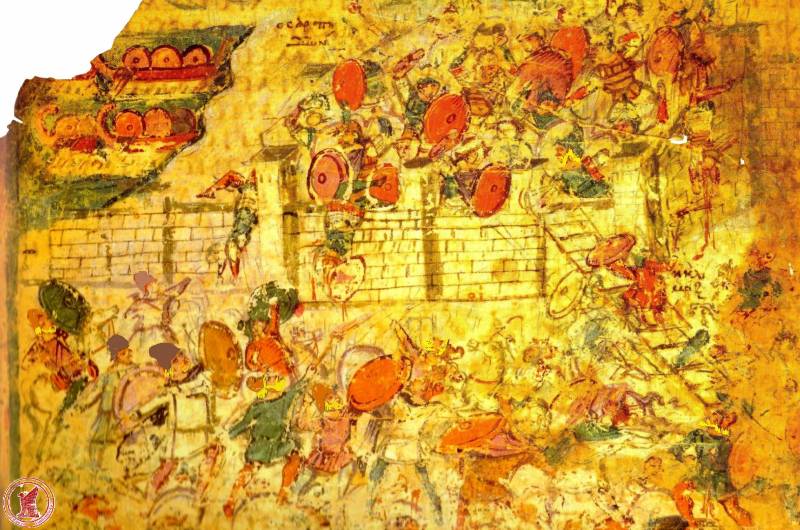
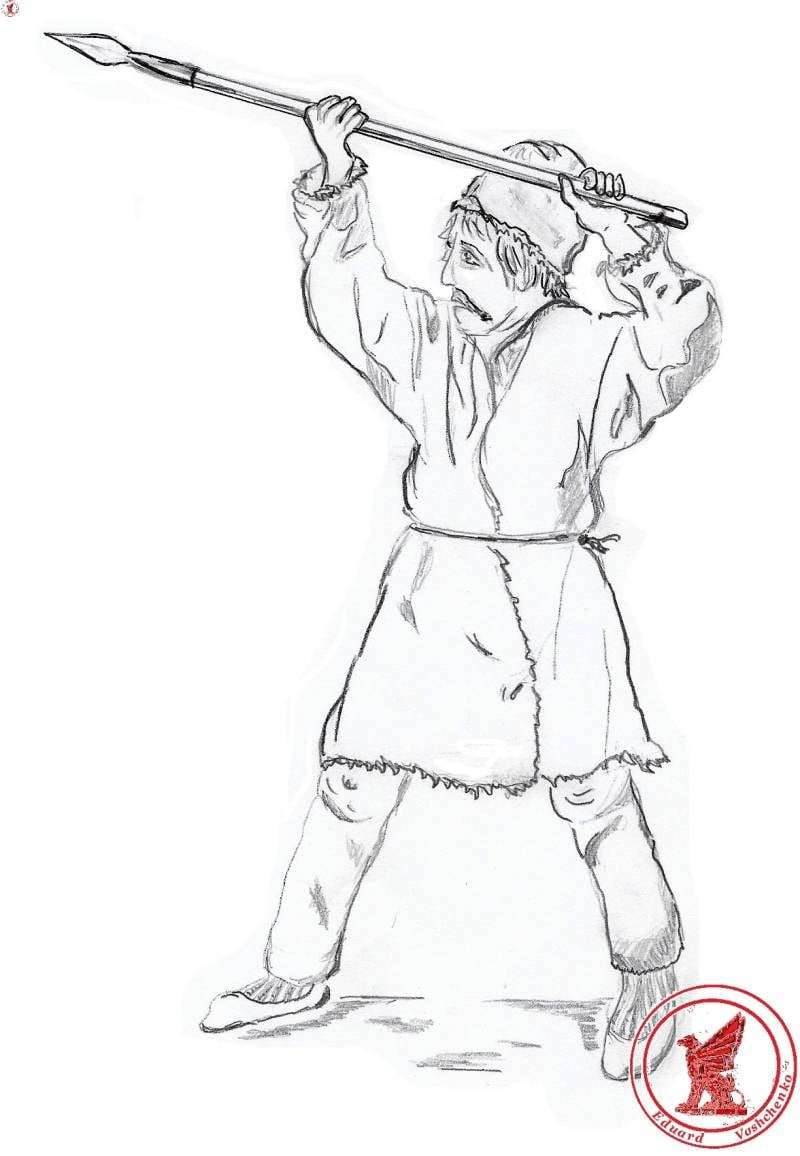
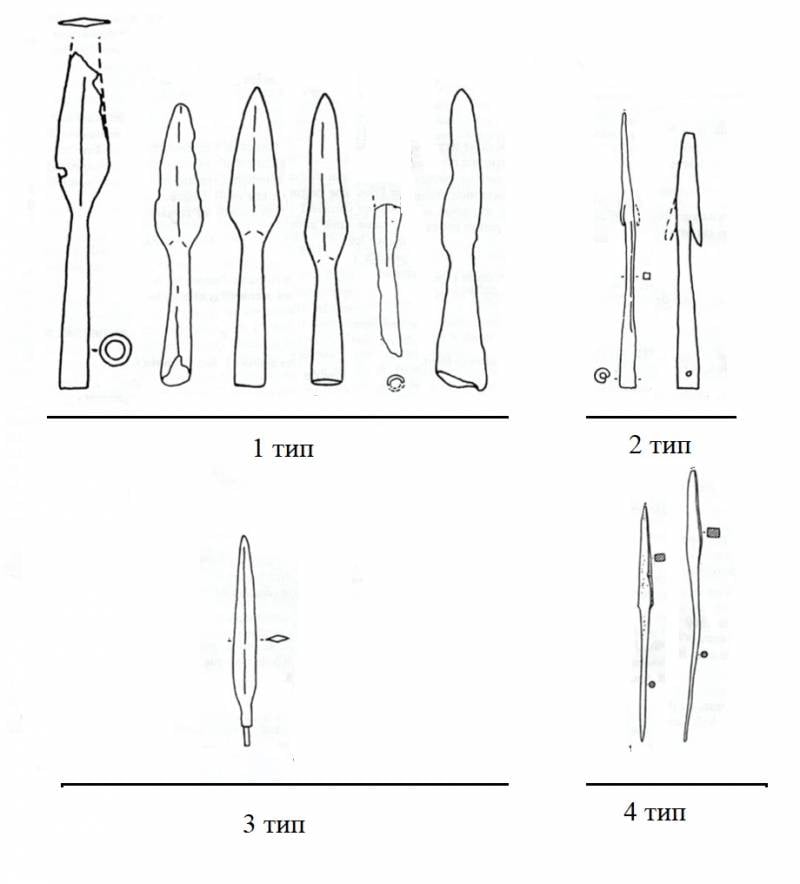
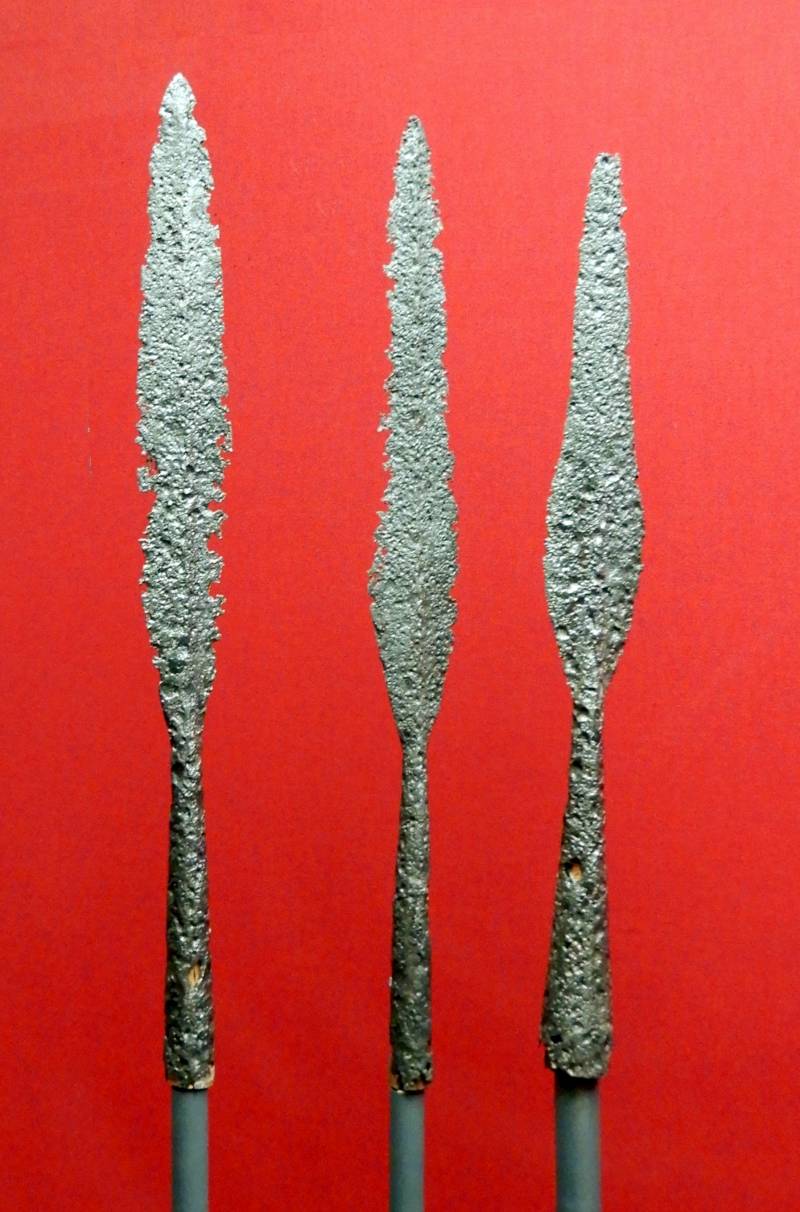
Information